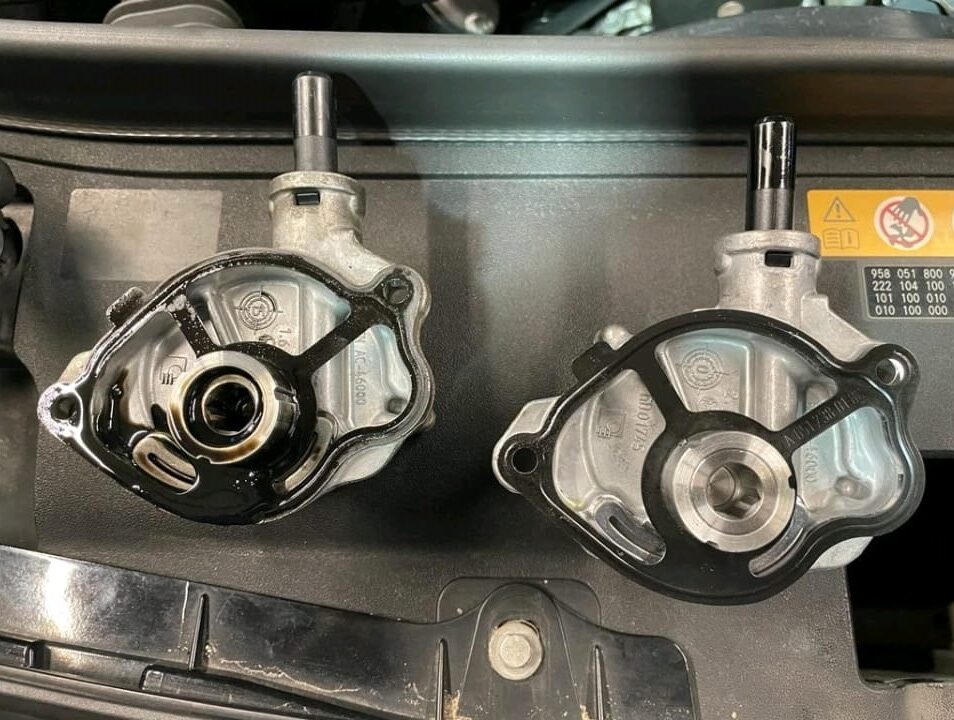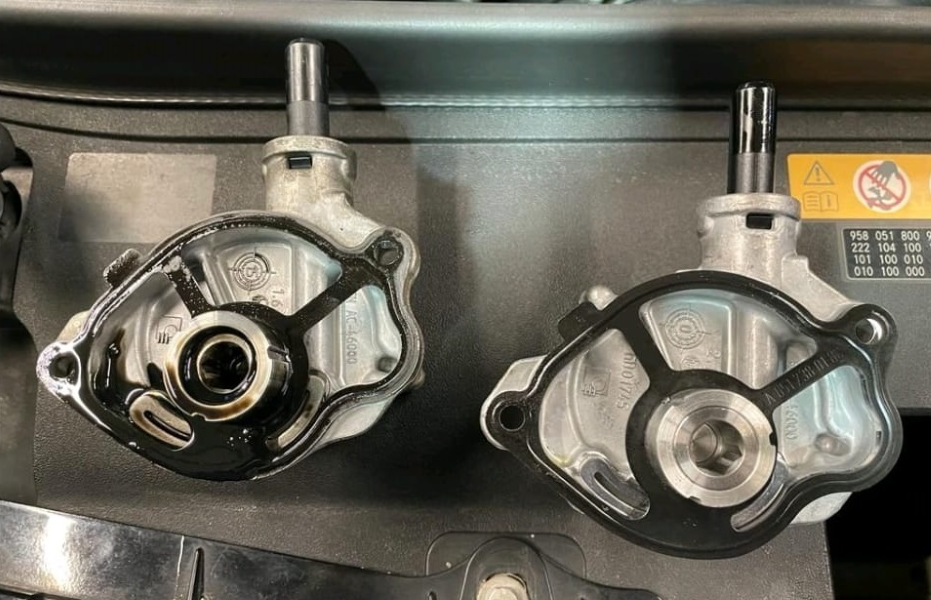Table of Contents
Hard Brake Issue in Mercedes-Benz S-Class W222: A Case Study
A hard brake pedal is one of the most alarming issues a driver can face. It indicates that brake assist is no longer functioning properly making braking effort much higher and compromising safety.
This real-world case study explores a Mercedes-Benz S-Class W222 equipped with the OM651 Engine, where the customer reported a hard brake with no braking power.
Our Mercedes technician performed a systematic diagnosis and repair, ultimately resolving the issue by replacing the mechanical vacuum pump the heart of the brake assist system.
For a full technical overview of how ABS, ESP, and Brake Assist systems work together to deliver braking safety, visit our Mercedes Brake System Problems: ABS, ESP & Brake Assist Guide.
Customer Complaint: Hard Brake with No Brake Power
The owner of a Mercedes-Benz S-Class W222 described the following symptoms:
- – Extremely stiff brake pedal, requiring excessive force.
- – Minimal braking response, even under hard pedal pressure.
- – ESP warning intermittently appearing on the dashboard.
These symptoms indicated a loss of vacuum-assisted braking, likely caused by a fault in the brake booster system or vacuum supply.
Diagnosis: Tracing the Cause of the Hard Brake
To resolve the issue, the technician followed a structured diagnostic process.
Step 1: Functional Pedal Check
Pressing the brake pedal confirmed the complaint the pedal was stiff and unresponsive.
This immediately pointed toward a vacuum or booster-related fault rather than hydraulic pressure loss.
Step 2: Brake Assist and Boost Power Check
Testing revealed no boost power was available to assist braking.
In Mercedes vehicles, the vacuum system provides the necessary negative pressure for the brake booster to reduce pedal effort.
A lack of vacuum assist meant the system was operating purely mechanically hence the hard pedal.
Step 3: Fault Code Analysis
A diagnostic scan using XENTRY Diagnosis retrieved fault code P05OFF associated with the Electronic Stability Program (ESP).
This fault code suggested a malfunction within the brake assist system, possibly caused by insufficient vacuum supply or a failed pump.
Step 4: Vacuum System Test
The technician performed a vacuum system test by:
- – Actuating the electric vacuum pump through the diagnostic tool.
- – Checking the vacuum hoses and check valves for leaks.
Results showed that the vacuum circuit was intact no leaks or line restrictions detected.
This ruled out a vacuum hose or booster leak and redirected attention to the mechanical vacuum pump.


Root Cause: Failed Mechanical Vacuum Pump
Further inspection revealed that the mechanical vacuum pump was no longer generating sufficient vacuum pressure to support the brake booster.
Without this pressure, the brake system could not provide the required assist force, causing the hard pedal condition.
Repair Process: Replacing the Mechanical Vacuum Pump
The technician replaced the faulty mechanical vacuum pump with a new OEM unit to restore proper vacuum pressure.



Repair Steps:
- 1. Remove engine cover and surrounding components for access.
- 2. Disconnect the vacuum line and electrical connector.
- 3. Unbolt and remove the defective mechanical vacuum pump.
- 4. Install the new pump with a fresh gasket and torque to specification.
- 5. Reconnect vacuum lines and verify system integrity.
- 6. Clear all ESP-related fault codes and recheck vacuum pressure levels.
After installation, a functional test confirmed:
- – Normal brake pedal feel restored.
- – No vacuum leaks.
- – Fault code P05OFF successfully cleared.
Result: Issue Resolved
Once the new vacuum pump was fitted, the vehicle’s brake assist returned to normal operation.
The pedal feel was smooth, braking response was immediate, and no further fault codes were present.
The driver could safely operate the vehicle without excessive pedal effort or risk of brake failure.

Technical Insight: Why Brakes Feel Hard
A hard brake pedal usually means the brake booster isn’t receiving vacuum pressure, which assists pedal movement.
In Mercedes vehicles, both mechanical and electric vacuum pumps can contribute to this system.
| Possible Cause | Description |
|---|---|
| Failed vacuum pump | No vacuum generated → no brake assist |
| Damaged vacuum hose / leak | Air entering system, reducing vacuum level |
| Faulty brake booster | Diaphragm inside booster fails, blocking vacuum effect |
| ESP module fault | Incorrect brake pressure modulation signal |
| Engine vacuum loss (diesel) | Turbo or EGR-related leaks affecting system pressure |
Is It Safe to Drive with Hard Brakes?
No, it’s not safe.
Driving with a hard brake pedal significantly increases stopping distances and can cause total brake assist loss.
Key Risks:
- 1. Reduced braking power: Requires excessive pedal force to stop.
- 2. Inconsistent braking: Brakes may feel unpredictable, especially in traffic.
- 3. Driver fatigue: Constant hard braking increases effort and slows reaction time.
- 4. Potential brake failure: The underlying issue (e.g., vacuum loss) can worsen.
- 5. Legal risk: Driving with compromised brakes may violate road safety regulations.
What You Should Do If You Experience Hard Brakes
- – Stop driving immediately and pull over safely.
- – Do not attempt to continue the vehicle may not stop in time.
- – Contact a qualified Mercedes technician to perform a vacuum system diagnosis.
- – Check both mechanical and electric vacuum pumps for operation.
- – Replace faulty components promptly to restore full brake assist.
Preventive Maintenance Tips
- – Inspect vacuum lines for leaks or cracks every 20,000 km.
- – Replace brake fluid every 2 years (DOT 4+ recommended).
- – Keep the engine oil clean sludge buildup can affect mechanical pump function.
- – Use OEM parts to maintain proper vacuum and brake pressure levels.
- – Regularly test brake pedal response after service or long storage periods.
FAQs
Q1: What causes a hard brake pedal in Mercedes vehicles?
A loss of vacuum pressure due to a failed mechanical or electric vacuum pump is the most common cause.
Q2: How do I know if my brake booster is faulty?
If the pedal remains hard even after replacing the pump and checking vacuum lines, the booster diaphragm may be leaking.
Q3: Can a hard brake issue trigger an ESP fault?
Yes. The ESP system monitors brake assist. If vacuum pressure drops, it logs a fault like P05OFF indicating insufficient brake assist.
Conclusion
This case study on the Mercedes-Benz S-Class W222 demonstrates how a faulty mechanical vacuum pump can lead to a hard brake condition and brake assist failure.
Through a precise diagnostic process, the technician identified the root cause, replaced the defective component, and restored safe braking performance.
Author Bio
Mercedes Expert is an automotive technical trainer and Mercedes-Benz diagnostics expert with extensive hands-on experience in XENTRY, DTS Monaco, and advanced system troubleshooting. He specializes in transforming real workshop case studies into structured learning content to help technicians, car owners, and enthusiasts understand complex vehicle systems.
Last update: October 2025






Leave a Reply